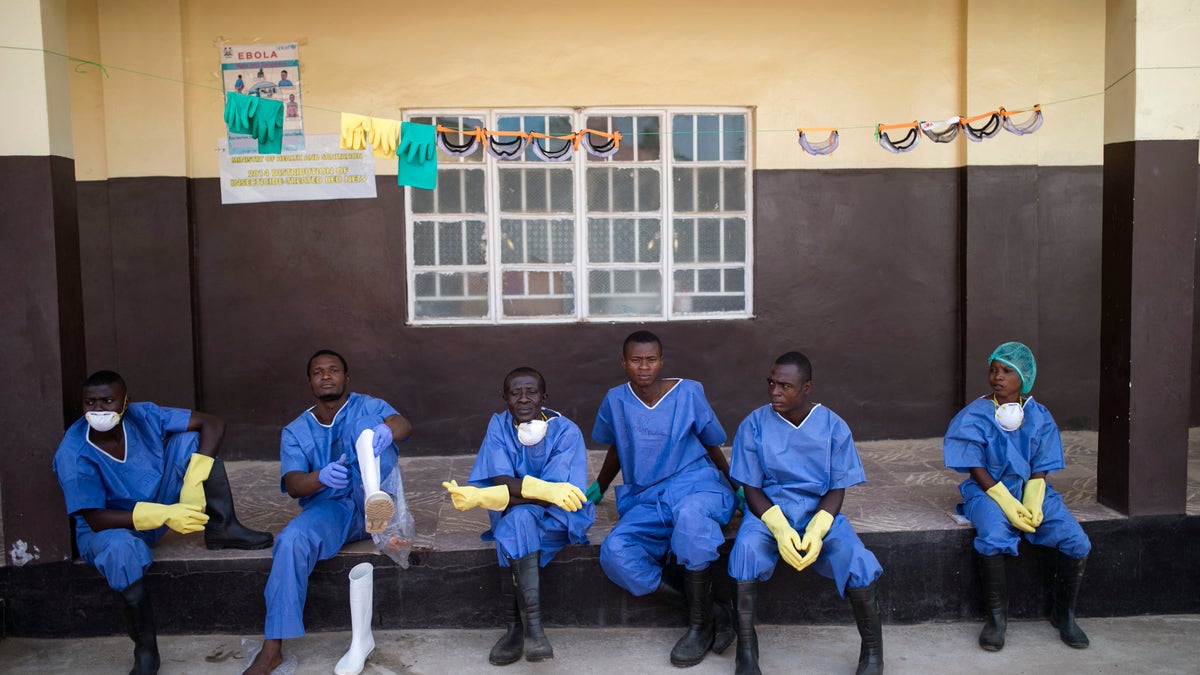
Health workers rest outside a quarantine zone at a Red Cross facility in the town of Koidu, Kono district in Eastern Sierra Leone December 19, 2014. REUTERS/Baz Ratner
When Dr Sekou Kanneh goes to work at his Sierra Leonean Ebola clinic, he will probably be in the "red zone" for many hours, ignoring by necessity strict limits that govern foreign colleagues fighting the epidemic.
Conditions at Kanneh's treatment center, the only Ebola unit in the country run by local staff, contrast to the purpose-built facilities where foreign volunteers who have flocked to Sierra Leone, Guinea and Liberia work.
Kanneh has received no official training to treat the virus that has killed over 7,000 people in West Africa. Still, he works up to four hour shifts in the stifling heat of the red zone, a ward where healthcare workers have direct contact with the highly contagious Ebola patients.
"We don't have time for surgery any more, and many of our surgeons are dead from Ebola," he told Reuters, rubbing his brow in the dense heat, his green medical gown dark with sweat.
Last week, U.S. medics showed United Nations Secretary General Ban Ki-moon around their air-conditioned treatment center near the Liberian capital, explaining how every precaution is taken to protect workers.
Highly-trained staff at the U.S. unit may stay in the red zone for a maximum of two hours - for good reason. Less time there means less risk of exposure to Ebola and of making possibly fatal mistakes. Workers must also avoid suffering dehydration in their polyethylene protective suits, which even with air conditioning are extremely hot to wear.
In the Sierra Leonean capital of Freetown, medical charity Medecins Sans Frontieres limits the time local and international staff spend in the red zone of its facility to about one hour.
"DOCTOR, I'M DYING"
Britain, France, Cuba and others have also sent doctors, and the foreign-run facilities are generally well funded. But things are different when Kanneh puts on his "PPE" - the personal protective equipment of a suit, gloves and mask - at his unit on the site of a former police academy.
"If you tell me to remove my PPE after 45 minutes and I hear a patient saying 'doctor, doctor I'm dying', then I won't leave," Kanneh said at his clinic in Hastings, a community just outside Freetown.
Reassurance is vital for those suffering symptoms such as vomiting, diarrhea and bleeding from eyes and ears. "The patients can't see faces because of the mask so the voice is really important," he told Reuters.
For Kanneh, who trained as a surgeon in Russia, the shifts are grueling. One recent Sunday, he found himself working alone to supervise treatment of 27 patients as one colleague was at church and another is recovering from the virus.
Of the three impoverished countries worst hit by the outbreak, Sierra Leone now has the most cases and the numbers are rising fastest; roughly half are in Freetown.
Sierra Leone had only 136 doctors before the epidemic struck and 12 of them have become infected, mostly fatally, including the country's leading doctor, Victor Willoughby. He died last week, a few hours after the arrival in Sierra Leone of an experimental drug that could have been used to treat him.
Across the three countries, 358 healthcare workers have died from Ebola, according to World Health Organization figures.
But the loss of Willoughby, who mentored a generation of Sierra Leonean medical students, was a particularly heavy blow to morale. Willoughby had won great respect for staying throughout a civil war that lasted more than a decade until 2002, rather than taking a more lucrative post abroad.
"We have lost too many in the battle," Kanneh said. "I don’t want them to be forgotten. We remember them each time we go back into the red zone."
FRUSTRATED AND EXHAUSTED
At the Hastings center, gloved workers walk along its open-air corridors with buckets, while a clergyman reads the Bible story of Lazarus - who was raised from the dead - to a handful of gaunt survivors.
Kanneh, who has no medical insurance, stays on site in a spartan room near the Ebola ward and is often on call overnight. Numbers of patients at Hastings have dropped since early December, thanks partly to six new facilities built by the British military.
But with funding falling far short of that for the foreign facilities, staff at Hastings are exhausted and frustrated. A pharmacist showed Reuters a list of around 180 staff members out of a total of 257 who say they have not received their full government wages and risk allowance.
"If you look at the risk allowance of white people, it's much higher. I'm angry. This is risky work," said Mohamed Marrah, who supervises workers as they don PPEs.
Even in centers run by Western groups, the majority of staff are local. Medecins Sans Frontieres has around 30 foreign workers and 250 Sierra Leonians at its Prince of Wales facility.
"It's not unrealistic for Sierra Leone doctors to have the same conditions as Western ones but somebody has to be prepared to fund that," said O.B. Sisay, director of the situation room at the National Ebola Response Centre.
